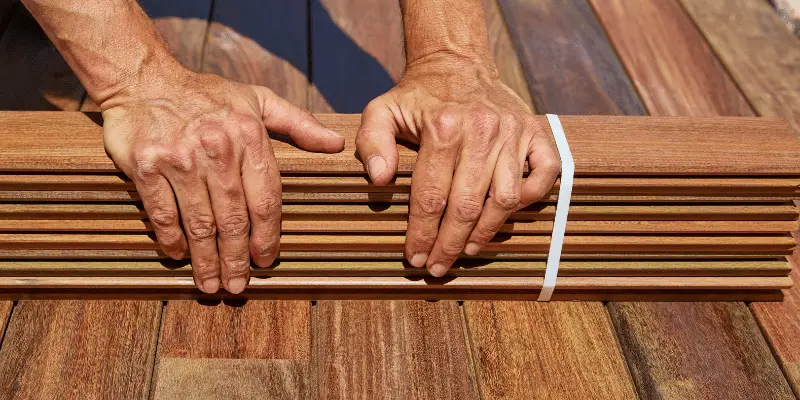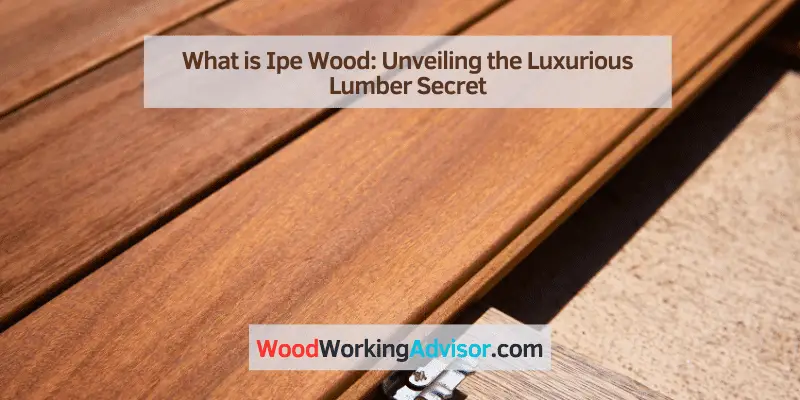Ipe wood, also known as Brazilian Walnut, is a dense, durable hardwood. It is prized for outdoor construction due to its natural resistance to decay, weather, and insect infestation.
Ipe is a popular choice for decking, siding, and flooring, recognized for its rich brown color and longevity. It’s one of the hardest woods available, often lasting over 40 years with proper maintenance. The wood’s tight grain and natural oils contribute to its exceptional toughness, making it a preferred material among builders and architects for outdoor applications.
Sourced primarily from South America’s tropical forests, Ipe’s strength and stability are matched by its environmental impact, making responsible sourcing important. Sustainability-conscious consumers should look for Ipe that is certified by the Forest Stewardship Council to ensure responsible forestry practices.
Origins And Characteristics
Ipe wood, also recognized as Brazilian Walnut, originates from the species Handroanthus, principally found in the forests of South and Central America. This highly sought-after timber is noteworthy for its extreme hardness and durability. Spanning across various countries, including Brazil, Peru, and Bolivia, the geographic distribution of the Ipe tree is largely focussed in tropical locales, which contribute to its unique characteristics.
Physical and mechanical properties set Ipe apart from other hardwoods. Known for its impressive density, Ipe wood has a fine grain texture that appeals aesthetically, and an incredible natural resistance to rot, decay, and insect infestation. This resilience is complemented by its strong bending strength, high resistance to abrasion, and an exceptional lifespan, making it a premium choice for outdoor decking and furniture.
Unraveling The Allure Of Ipe
Ipe wood, renowned for its striking beauty, features a fine-to-medium grain pattern with a rich brown color and natural luster. The interlocked grains give ipe a unique texture, enhancing its aesthetic appeal for various applications like decking, outdoor furniture, and flooring.
The impressive durability of ipe wood is attributed to its dense cellular structure, providing incredible resistance to rot, decay, and insect infestation. It has a Class A fire rating, the same as concrete and steel, and can last up to 40 years if properly maintained. Its resilience against harsh weather conditions makes it a prized material for outdoor use.
When matched with other hardwoods, ipe wood stands out due to its superior properties. It surpasses popular hardwoods like cedar and redwood in terms of hardness and lifespan, confirming its status as a premium decking material. Its maintenance requirements are relatively low, although regular oil treatments can enhance its color and longevity.
Ipe Wood Applications
Ipe wood is renowned for its impressive durability and resistance to decay, making it an ideal material for outdoor applications. Decking stands out as one of its most prominent uses due to its ability to withstand harsh weather conditions and maintain its integrity over time. The wood’s natural oils not only contribute to its longevity but also eliminate the need for constant maintenance.
The unique aesthetics and high density of Ipe wood make it an excellent choice for fine furniture and interior design projects. Designers and woodworkers value its deep rich color and fine grain, which lend a touch of elegance and luxury to indoor spaces.
Because of its versatility, Ipe wood is also crafted into a variety of specialty items, ranging from cutting boards to musical instruments. Its uncommon properties allow artisans to create unique and long-lasting products that stand out for their quality and craftsmanship.
Ethical Harvesting Practices
Ipe wood, known for its durability and longevity, is often sought after for high-end decking and outdoor furniture. Sourcing Ipe wood ethically is crucial to minimize the negative impact on local ecosystems. Responsible suppliers adhere to strict certifications that ensure sustainable harvesting practices.
The most recognized certification is the Forest Stewardship Council (FSC), which guarantees that the wood comes from responsibly managed forests that provide environmental, social, and economic benefits. FSC-certified suppliers must follow a comprehensive set of rules that protect the environment and the rights of indigenous peoples. The Lacy Act also plays a role in combating illegal logging, ensuring that only legally sourced Ipe wood enters the market, thereby supporting the conservation of biodiversity.
| Certification | Description | Impact |
|---|---|---|
| FSC Certification | Ensures wood is sourced from responsibly managed forests. | Positive impact on local ecosystems and communities. |
| Lacy Act Compliance | Prevents the trade of illegally sourced wood products. | Reduces destruction of habitats and promotes sustainability. |
Navigating The Market
Identifying quality Ipe Wood can be challenging, but there are key characteristics to look out for. High-density and a fine grain texture are indicative of top-notch Ipe. The color should be uniform and rich, ranging from reddish-brown to olive hues. Ensuring that the wood has minimal knots and sapwood can also signify quality. It is essential to verify that the Ipe comes from a sustainable source, proven by certification such as the Forest Stewardship Council (FSC).
| Quality | Price Range | Availability |
|---|---|---|
| Premium | $3.50 – $5.00 per linear foot | Seasonally limited |
| Standard | $2.50 – $3.49 per linear foot | Widely available |
The market offers various price points for Ipe Wood, reflecting its quality and scarcity. Premium options are pricier but provide the best durability and appearance. Standard selections are more affordable while still maintaining good quality. Availability fluctuates with demand and sustainable harvesting practices, with higher-end grades often being less accessible due to conservation efforts and seasonal harvesting cycles.
Maintenance For Longevity
Ipe wood, known for its durability and beautiful appearance, requires periodic cleaning and maintenance to ensure it retains its luster over time. To keep your Ipe looking its best, regular sweeping to remove debris combined with gentle washing with a mild soap and water solution is recommended. It’s important to allow the wood to fully dry after cleaning.
For those inevitable tougher stains, a cleaning formulation specifically designed for use on Ipe can be employed. Applying this cleaner with a soft brush can help in retaining the wood’s natural beauty without causing damage.
| Refinishing and Restoration Practices |
|---|
| Periodic Application of Oil Finish |
| Sanding to Remove Surface Irregularities |
| Protecting from Excessive Moisture and Sunlight |
Refinishing may become necessary to restore Ipe wood’s original appeal. This can be achieved through sanding the wood slightly to remove any surface irregularities followed by the application of a quality oil finish that will protect and enhance the wood’s rich color. Ensuring that the wood is kept safe from excessive moisture and direct sunlight can also significantly reduce the necessity for frequent refinishing. Implementing these practices can greatly contribute to your Ipe wood’s longevity.
Common Challenges
Ipe wood, renowned for its durability and resilience, is a popular choice for outdoor applications. Nonetheless, it’s pivotal to consider the weather implications that can affect its performance. Over time, exposure to sunlight and moisture can lead to fading colors and potential warping if not appropriately treated or installed.
Installation considerations for Ipe wood are equally crucial. Its hardness requires pre-drilling to prevent splitting, and specific galvanized or stainless-steel fasteners are necessary to avoid corrosion. Proper spacing is also essential as it accommodates for wood expansion and contraction, thereby preventing buckling or gaps. Failure to adhere to these guidelines can compromise the longevity and aesthetics of the installation.

Mastering Ipe Woodwork
Ipe wood, prized for its impressive durability and natural beauty, presents unique challenges and rewards. Crafting with Ipe demands specific tools due to its hardness and density. For successful cutting, carbide-tipped saw blades are essential, and pre-drilling is recommended when screwing to prevent splitting. When joining Ipe, traditional woodworking joints like mortise and tenon or biscuit joints are highly effective.
Finishing Ipe wood, while not always necessary due to its natural oils, can highlight its rich tones. An oil-based finish specifically designed for hardwoods can enhance its longevity and appearance. UV inhibitors in the finish help in maintaining the wood’s color, which otherwise naturally silvers over time. Regular cleaning and a fresh coat of finish every few years will keep Ipe woodwork in pristine condition.
Creative Projects And Ideas
Ipe wood, known for its exceptional durability and striking beauty, is a top choice for creative projects. In particular, its resilience makes it perfect for outdoor applications, where it can endure harsh weather without succumbing to decay. Notable for its dense grain, Ipe is also resistant to insect damage, enhancing its lifespan significantly compared to other woods.
A favorite among woodworkers, Ipe is widely utilized for building high-quality furniture that boasts both sturdiness and a premium finish. Its rich color palette, ranging from reddish-brown to olive tones, deepens with age and exposure to the elements, adding character to each piece. Ipe’s ability to maintain its integrity under heavy use is particularly beneficial for crafting decking, patios, and outdoor kitchens, which become both functional spaces and works of art.
Its versatility extends into intricate woodwork, such as detailed carvings or inlays in custom flooring. The wood’s tight grain allows for precise cuts, elevating the level of sophistication in interior design. For a truly inspirational application, Ipe can be used to create stunning architectural elements, like accent walls or ceiling beams, adding a touch of natural elegance to any space.
Frequently Asked Questions On What Is Ipe Wood
What Are The Disadvantages Of Ipe Decking?
Ipe decking disadvantages include high cost, potential for heat retention, regular maintenance for color preservation, difficulty in cutting and installing, and being heavy, which can complicate transportation and handling.
Why Is Ipe Toxic?
Ipe wood contains natural oils and chemical compounds that can cause respiratory or allergic reactions, making it toxic for some individuals. These chemicals are a defense mechanism to protect the tree from decay and insect infestation.
Why Is Ipe So Expensive?
Ipe wood is expensive due to its high durability, resistance to rot, and scarcity. Its dense composition requires more labor for harvesting and manufacturing, further driving up costs.
Is Ipe Wood Water Resistant?
Yes, IPE wood is highly water resistant due to its dense cellular structure, making it ideal for outdoor and marine applications.
Conclusion
Wrapping up our journey through the realm of Ipe wood, it’s clear why this material stands out. Its durability, beauty, and low-maintenance qualities make it a top pick for anyone desiring longevity and elegance in wood projects. Next time you’re choosing materials, remember Ipe’s exceptional qualities for an investment that truly lasts.


